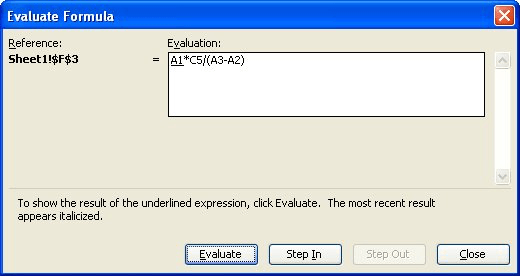Please Note: This article is written for users of the following Microsoft Excel versions: 2002 and 2003. If you are using a later version (Excel 2007 or later), this tip may not work for you. For a version of this tip written specifically for later versions of Excel, click here: Evaluating Formulas.
Often it is frustrating to figure out exactly how Excel arrives at a particular result—particularly if the formula returning the result is quite complex. Fortunately, Excel provides a tool you can use to help figure out what is going on when Excel evaluates a formula. To access this tool, follow these steps:

Figure 1. The Evaluate Formula dialog box.
At this point, Excel shows the full formula from the cell, and part of it is underlined. This underlined area represents the part of the formula that Excel will next evaluate. This allows you to see what intermediate steps Excel follows in arriving at a result. Every time you click the Evaluate button, Excel replaces the underlined portion of the formula with a result.
Nothing you do with the formula evaluator actually affects the formula in your worksheet; it remains unchanged. Instead, Excel simply shows you what happens as it works through each part of the formula to arrive at a result. When you are done using the formula evaluator, click the Close button.
ExcelTips is your source for cost-effective Microsoft Excel training. This tip (2999) applies to Microsoft Excel 2002 and 2003. You can find a version of this tip for the ribbon interface of Excel (Excel 2007 and later) here: Evaluating Formulas.

Best-Selling VBA Tutorial for Beginners Take your Excel knowledge to the next level. With a little background in VBA programming, you can go well beyond basic spreadsheets and functions. Use macros to reduce errors, save time, and integrate with other Microsoft applications. Fully updated for the latest version of Office 365. Check out Microsoft 365 Excel VBA Programming For Dummies today!
Postal codes in Canada consist of six characters, separated into two groups. This tip explains the format and then shows ...
Discover MoreA common task faced by Excel users is to determine whether items in one list are also found in a different list. There ...
Discover MoreThe way you signify that you are entering a formula is to start a cell entry with an equal sign. Here is the reason why ...
Discover MoreFREE SERVICE: Get tips like this every week in ExcelTips, a free productivity newsletter. Enter your address and click "Subscribe."
2016-12-05 13:24:15
Willy Vanhaelen
@Thomas
Even shorter, instead of Ctrl+= you can simply press F9.
2016-12-04 03:26:52
Thomas Papavasiliou
Another alternative:
In edit mode, select the part of the formula you want to evaluate and press Ctrl+=
Excel evaluates that part and displays it in the formula bar.
If you are happy with the result, press Enter and the evaluated part replaces the selection. If you press escape you get back to your original formula.
Got a version of Excel that uses the menu interface (Excel 97, Excel 2000, Excel 2002, or Excel 2003)? This site is for you! If you use a later version of Excel, visit our ExcelTips site focusing on the ribbon interface.
FREE SERVICE: Get tips like this every week in ExcelTips, a free productivity newsletter. Enter your address and click "Subscribe."
Copyright © 2026 Sharon Parq Associates, Inc.
Comments